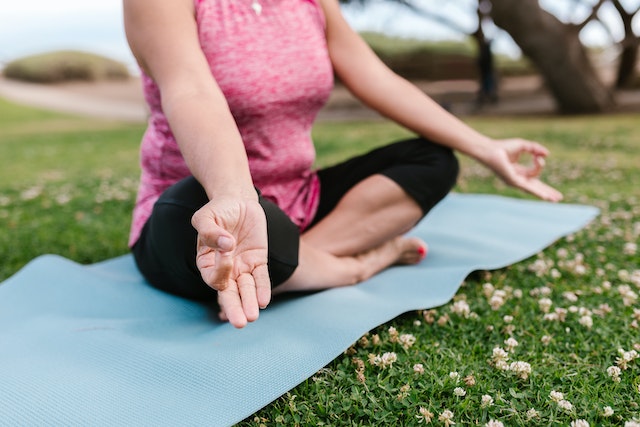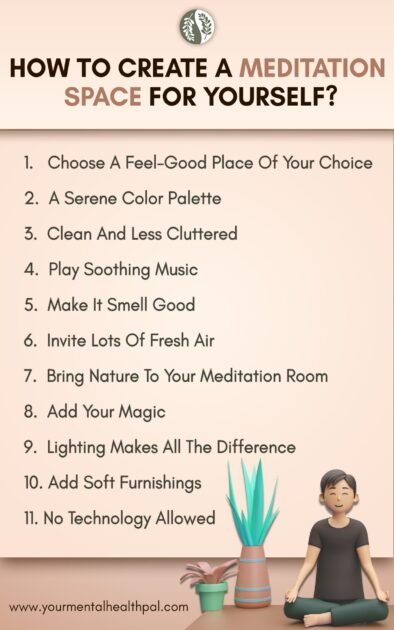Need a breather from the overwhelming world around you?
“Me too,” says everybody.
Between all our stress and daily issues, we often forget to carve out that ‘me’ time for ourselves. Sometimes all we need is a spot that allows us to bliss out from the world.
A meditation spot does precisely that for you. It allows you to have your ‘me ‘ time while reaping the maximum benefits of practicing meditation.
Just think of having a meditating space in your house that helps heal your mind and soul. Exciting right? A space devoted to peace, tranquility, and your emotional well-being. A space that enables you to escape your reality and connect with yourself.
Knowing how to create your own meditation space will give you precisely what you want – a better chance at mental peace and serenity.

How To Create a Meditation Space
Practicing meditation will give you a sense of calm, belongingness, peace, and balance that can benefit your emotional well-being and physical health.
However, there is no specific rule for meditating in a room. You can meditate wherever you feel like- a garden, balcony, room, etc. The idea here is that if you are planning to create an entire meditation space and wondering how to create a meditation space, here’s a list that can help you.
Take some inspiration from the listed 11 ways but don’t forget to listen to your mind and heart. Adding elements you love can create a personal feeling and enhance a deep meditation.
11 Ideas On How To Create A Meditation Space In Your Own Home

1. Choose A Feel-Good Place Of Your Choice
While learning how to make a meditation space, the first step is to choose a space that gives you positive vibes. It can be anywhere – a corner part of your bedroom, balcony, garden, etc. The only criterion is that it should be able to make you smile the moment you walk in there.
Additionally, since you have to meditate, choose a space that has less clutter. Pay attention to the lighting as well. If you are lucky enough to have a room in the house which faces lush green trees, soothing blue water, natural sunlight, or a beautiful flowery garden, it couldn’t be better.
All these elements can indeed light up your mood when you do meditation. If you cannot find these features in your room, you can even look for an outdoor space, such as a garden or terrace.
If you are preparing to set up a room that does not have these natural features, you can just add some elements that can make you feel connected with nature, like plants, posters, efficient lighting, etc. Choosing a feel-good space will allow your mind and body to relax without being distracted.
2. A Serene Color Palette
When choosing the room, don’t forget about the room’s color palette. Paint the room to fit the mood you are attempting to achieve.
Some people prefer a pastel palette. Pastel shades are more soothing and relaxing. You can also choose light or white shaded walls. Some prefer a very dark paint palette -black or extremely bright colors. They say it helps make the room feel surrounded and safe, further aiding in mental relaxation.
You can even consider putting up a wallpaper of your choice or adding light-colored sheer curtains for the windows to help add more light, depth, and space to your room. The room’s color can affect your mood to a great extent, so choose the colors that feel soothing to your eyes and makes you calm and relaxed.
3. Clean And Less Cluttered
There is nothing more distracting than a cluttered and disorganized area. Therefore, choosing wide-open spaces is an integral part of knowing how to create a mediation space. A wide-open space helps you focus and meditate better than a stuffy room. If you plan to use up space in your bedroom, make sure that the area is less cluttered. Try to keep a minimal amount of elements to keep your meditation space neat and empty. Consider adding only essential features such as a yoga mat, a coffee table, pillow, etc.
4. Play Soothing Music
While learning how to set up a meditation space, how can we leave music behind?
Soft music can genuinely enhance your meditation process. Choose soft instrumental or meditative music to make your experience better.
When played softly in the background, music can help block out all the other distractions in your home, enabling you to enter a calm and relaxed meditational state.
5. Make It Smell Good
Another element you must consider while learning how to create a meditation room is aromatherapy. You can choose a wide variety of fragrances. Not only does aromatherapy help you to relax, but the use of essential oils such as lavender, peppermint, and orange can soothe your mind and soul. Aromatherapy is also believed to help in reducing mental stress, relieving muscle pain, and immunity-boosting.
Read More: Essential Oils and Aromatherapy
6. Invite Lots Of Fresh Air
Besides aromatherapy, fresh air is also a crucial component in any meditation space.
If you make your meditative space outdoors, it will not be a problem. However, if you are planning to dedicate a room for meditation, make sure that the room is well-ventilated so that you have a direct source of fresh air to help you feel the cool breeze. Fresh air helps you feel refreshed and improves your brain power and overall health.
7. Bring Nature To Your Meditation Room
Most people believe that meditation is a process of connecting oneself with nature and its surroundings. Therefore, it is ideal to meditate in an open environment full of lush green grasses and a blooming river. But we understand that it’s not possible for everyone to do so in reality. However, adding touches of nature to your meditation can make a big difference.
It can be a small plant, flower pot, small water fountain showpiece, etc. These elements can make you feel the healing power of nature, and your room will be instantly infused with balance and harmony. Similarly, the soothing sound of the water fountain will help you enhance a more profound meditation.
Read more: 11 Best Positive Energy Plants For Your Home
8. Add Your Magic
When learning how to create a meditation space, you should definitely include some of your own personal touches to inculcate a sense of belongingness with the space. This could be any element – wind chimes, affirmation stones, diary, artwork, etc.
But always remember that you should not overcrowd the space. Keep it clean and less cluttered as much as possible. If you can’t decide between various things, choose a few pieces at a time and then swap them with other items from time to time.
9. Lighting Makes All The Difference
As we mentioned earlier, find a place that is open and connects you to nature or a room that has tons of natural sunlight. Lighting can make all the difference. If you are practicing meditation outside with a bright sun, use a shade or an umbrella to prevent the sun from irritating your eyes.
If you are meditating inside a room, ensure that your room has windows in it. If your room lacks natural light, focus on the light fixtures and have adequate lighting options. Try to avail both the possibilities of dim and bright lights as your mood can change from day to day, and you may prefer lights according to your mood.
10. Add Soft Furnishings
Comfort is a priority. You would obviously need some furnishings just to lay down and relax. Some large cushions, bean bags, sheepskins, and blankets can be added to your meditation room. These items don’t take much space and provide great comfort.
11. No Technology Allowed
There is no hard and fast rule as to how to design a meditation room except for one. No electronic items are allowed. All the electronics except your music player should be out of your meditation room. Since meditation is your “me-time,” try to enjoy it as much as possible.
The random ‘pings’ of phone calls, text messages, emails, and notifications just destroy the aim of what you are trying to achieve- a peaceful and relaxed mind. Make sure you switch off your phones or keep them in a silent mode away from you. The whole idea is to disconnect from reality so that you can connect with your inner-self and find peace.
Conclusion
We hope these ideas on how to create a meditation space for yourself will help you create a safe and peaceful haven for yourself. However, don’t be afraid to try things that allow you to connect deeply with yourself. You know yourself much better. Look inward, then reflect this onto your meditation space.
Now that you have figured out how to create a meditation space for yourself, let’s shift gears and move ahead. It’s time to figure out the perfect meditation technique for you. To find out more about the technique that will help you the most, click here.To learn more about mental health and well-being, subscribe to Your Mental Health Pal.

